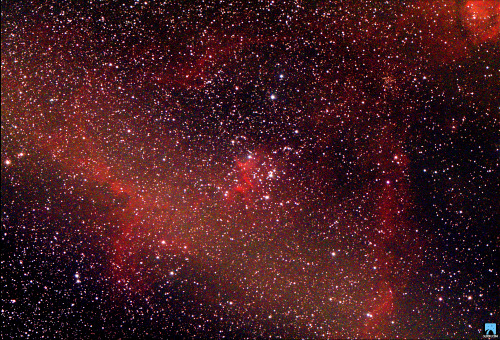-aurora Borealis-



-aurora borealis-
More Posts from Shibushiuniverse and Others

This is the Heart Nebula! 💖💖💖
Happy Valentine’s Day! To celebrate this occasion, here is the beautiful Heart Nebula, an emission nebula with dark dust lanes and glowing red hydrogen gas. The heart shape of the nebula is driven by stellar winds from the hot stars inside, some of which have masses up to 50 times the Sun! 💕💕💕
Taken by me (Michelle Park) using the Slooh Canary Two telescope on February 7th, 2022 at 21:13 UTC.
Art

Omega in Sagittarius © blastrophoto

NGC 6995: The Bat Nebula : Do you see the bat? It haunts this cosmic close-up of the eastern Veil Nebula. The Veil Nebula itself is a large supernova remnant, the expanding debris cloud from the death explosion of a massive star. While the Veil is roughly circular in shape and covers nearly 3 degrees on the sky toward the constellation of the Swan (Cygnus), NGC 6995, known informally as the Bat Nebula, spans only ½ degree, about the apparent size of the Moon. That translates to 12 light-years at the Veil’s estimated distance, a reassuring 1,400 light-years from planet Earth. In the composite of image data recorded through narrow band filters, emission from hydrogen atoms in the remnant is shown in red with strong emission from oxygen atoms shown in hues of blue. Of course, in the western part of the Veil lies another seasonal apparition: the Witch’s Broom Nebula. via NASA
Tuesday 12th July, 14:30 UTC
Make a note in your own time zone Zespacebloggers, probably the biggest event in astronomy in our lifetimes is about to drop a large amount of images and data from the new JWST.
Nasa has kindly provided us with a few images that are amongst the first targets of the JWST, some very familiar to those on this blog, and others that may become the new iconic images as we move from the Hubble era into the JWST one.

The Carina Nebula, a common feature here, and one of the most spectacular nebula's in our night sky. The nebula is located 8,500 light years from Earth in the constellation of Carina and contains the famous Eta Carina.

Next on the list is an exoplanet, WASP 96 B, a planet half the size of Jupiter orbiting it's sun every 3.4 days, and JWST has managed to capture a spectrum of light from the atmosphere of this planet as it passes between us and it's star. While this won't be a pretty picture of a planet, the ability to read the spectrum of light from a exoplanet, will allow us to give a much better view of the atmosphere and what it's actually made up of, not bad for a planet over 1,150 light years from Earth.

Next up is the Southern Ring Nebula NGC 3132, 2,000 light years from Earth in the constellation of Vela. This is a planetary nebula, the final shedding of the atmosphere of a star that was once not too dissimilar to our own sun. If you look closely you can see there are two stars in the centre, the white dwarf responsible for the ring is the small dot just above a binary partner star that has yet to end it's life. The heat from the tiny white dwarf is what is responsible for the nebula glow, as it bombards it with UV radiation.

Stephan's Quintet featured here recently, is a group of galaxies 290 million light years from Earth, I personally can't wait to see this one from JWST.

Finally there is SMACS 0723, a distant cluster of galaxies that include many examples of gravitational lensing, and I would suspect, this is the deep space image that is attempting to use that gravitational lensing to see further back in time than ever before, just a 100+ million years after the big bang.
There's a HUGE amount to look forward to this week, and just as we still turn to Hubble to take our breath away, the material coming from JWST will continue to do this long into the future.




Spatial veils of light
-
 wachsurfer2018 liked this · 2 years ago
wachsurfer2018 liked this · 2 years ago -
 shibushiuniverse reblogged this · 2 years ago
shibushiuniverse reblogged this · 2 years ago -
 shibushiuniverse liked this · 2 years ago
shibushiuniverse liked this · 2 years ago -
 intihar-kalemimden-yaslar liked this · 4 years ago
intihar-kalemimden-yaslar liked this · 4 years ago -
 lunethea reblogged this · 6 years ago
lunethea reblogged this · 6 years ago -
 kaweheokalani reblogged this · 7 years ago
kaweheokalani reblogged this · 7 years ago -
 kaweheokalani liked this · 7 years ago
kaweheokalani liked this · 7 years ago -
 fraeulein-freitag liked this · 7 years ago
fraeulein-freitag liked this · 7 years ago -
 thefelipereyes reblogged this · 7 years ago
thefelipereyes reblogged this · 7 years ago -
 thefelipereyes liked this · 7 years ago
thefelipereyes liked this · 7 years ago -
 hypno-sinner liked this · 7 years ago
hypno-sinner liked this · 7 years ago -
 chaotic-hypnotic-erotic reblogged this · 7 years ago
chaotic-hypnotic-erotic reblogged this · 7 years ago -
 vellichorprincess reblogged this · 7 years ago
vellichorprincess reblogged this · 7 years ago -
 vellichorprincess liked this · 7 years ago
vellichorprincess liked this · 7 years ago -
 sanctimonioushollywood liked this · 7 years ago
sanctimonioushollywood liked this · 7 years ago -
 chaotic-hypnotic-erotic liked this · 7 years ago
chaotic-hypnotic-erotic liked this · 7 years ago -
 foxovermatter liked this · 7 years ago
foxovermatter liked this · 7 years ago -
 2000-kill reblogged this · 7 years ago
2000-kill reblogged this · 7 years ago




